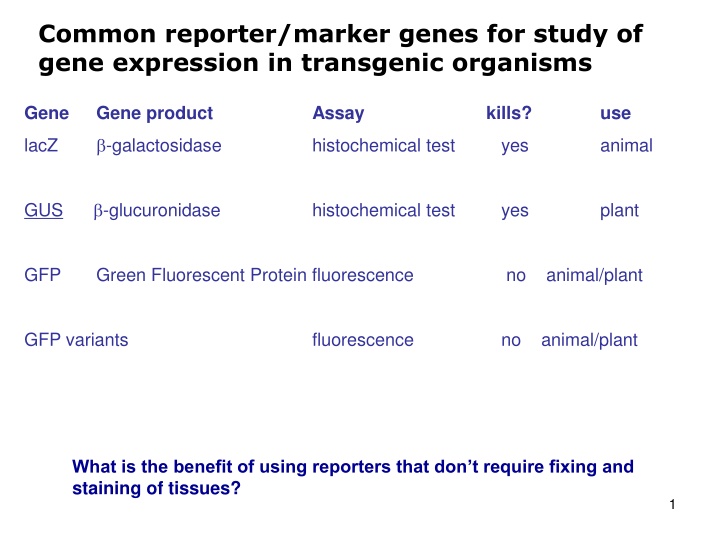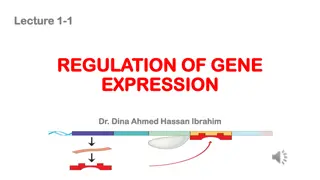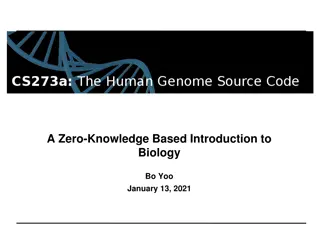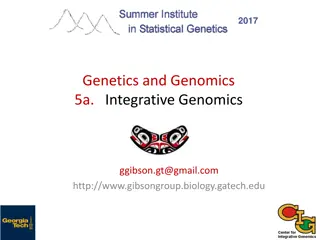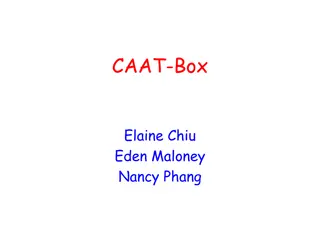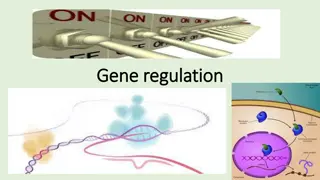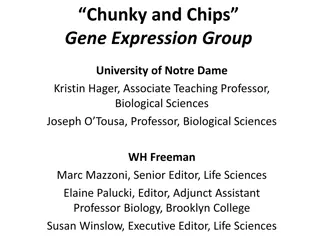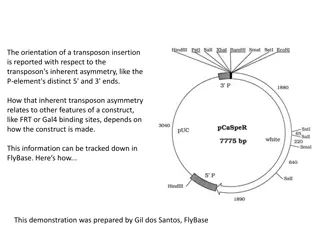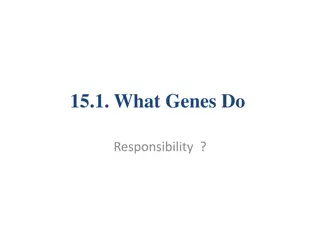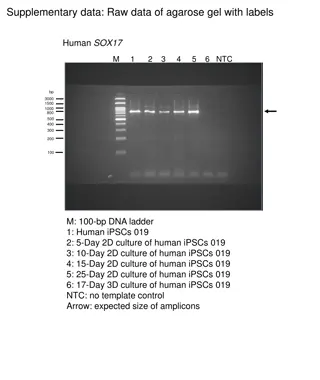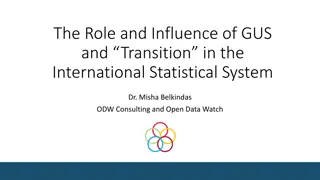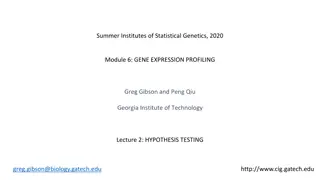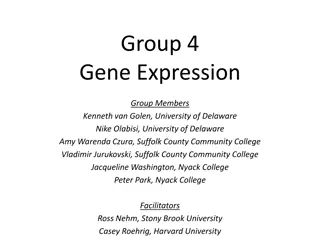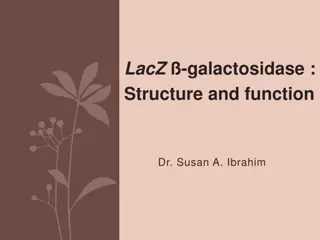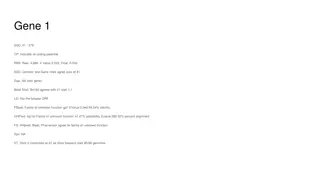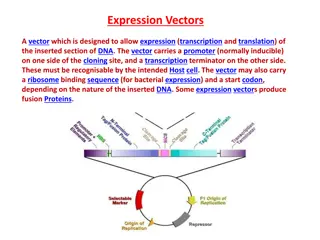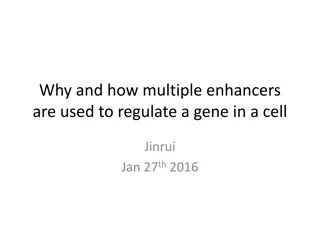Reporter Genes in Gene Expression: Utilizing LacZ, GUS, and GFP
Reporter genes like LacZ, GUS, and GFP play a crucial role in studying gene expression in transgenic organisms. LacZ and GUS provide histochemical assays for animal and plant studies, while GFP enables fluorescence visualization. Using reporters that don't require fixing and staining of tissues offers the benefit of simplifying and expediting the analysis process. These genes encode enzymes or proteins that produce specific signals, aiding researchers in tracking gene expression patterns with efficiency.
Download Presentation

Please find below an Image/Link to download the presentation.
The content on the website is provided AS IS for your information and personal use only. It may not be sold, licensed, or shared on other websites without obtaining consent from the author.If you encounter any issues during the download, it is possible that the publisher has removed the file from their server.
You are allowed to download the files provided on this website for personal or commercial use, subject to the condition that they are used lawfully. All files are the property of their respective owners.
The content on the website is provided AS IS for your information and personal use only. It may not be sold, licensed, or shared on other websites without obtaining consent from the author.
E N D
Presentation Transcript
Common reporter/marker genes for study of gene expression in transgenic organisms Gene Gene product Assay kills? use -galactosidase lacZ histochemical test yes animal GUS -glucuronidase histochemical test yes plant GFP Green Fluorescent Protein fluorescence no animal/plant GFP variants fluorescence no animal/plant What is the benefit of using reporters that don t require fixing and staining of tissues? 1
GUS (uidA) gene encoding a -glucuronidase enzyme Histochemical assay (assay in tissue) -glucuronidase Blue precipitate that does not diffuse out of cells X-Gluc 5-bromo-4-chloro-3-indolyl - -D-glucuronic acid 2
Lac Z gene Encodes a -galactosidase enzyme Histochemical assay (assay in tissue) -galactosidase Blue precipitate that does not diffuse out of cells X-gal 5-bromo-4-chloro-3-indolyl - -D-galactopyranoside 3
GFP (green fluorescent protein)-encoding gene from the jellyfish Aequorea victoria Fluoresces green light on irradiation with blue light observed by fluorescence microscopy A. thaliana wild type (left) 35S-gfp transformed (right)4 jellyfish Aequorea victoria
Green Fluorescent Protein (GFP) Many spectral variants have been produced by mutagenesis: Yellow (YFP) Excitation Emission Green (GFP) Yellow (YFP) red (RFP) Cyan (CFP) Red (RFP) 5
1-5000 ORF T Constructs: Nucleotides 1-5000 upstream GFP T Nucleotides 2000-5000 upstream GFP T Nucleotides 1-3000 upstream GFP T Nucleotides 1-2000 GFP T Nucleotides 3000 - 5000 GFP T 6 Write down the part of the upstream sequence responsible for the expression pattern
Transcriptional versus translational fusion to marker gene Transcriptional marker gene fusion: A promoter fragment is fused directly to the marker gene, which is what will be transcribed (A). Translational marker gene fusion: A promoter fragment and the whole or part of the genes open-reading-frame (protein- encoding region) is fused with the marker gene open-reading-frame so that a continuous translational fusion of protein is produced (B). http://www.wormbook.org/chapters/www_reportergenef usions/reportergenefusions.html 7
Translational fusion can be in the middle or 3 end of the gene as well as the 5 end (previous slide) fusion in frame with gene of interest: stop codon is removed, and the ORF continues into the reporter gene such that a fusion protein will be made. ORF will stop at stop codon in reporter gene. 3 PROMOTER exon 1 intron exon 2 REPORTER GENE We must pay attention to the reading frame of reporter gene and gene of interest. If they are different, one or both proteins won t be made correctly What additional information can we get about the gene function if we make a translational fusion? We are essentially labeling the protein. 8
Fusion type Contains 5 regulatory elements Contains cis elements that may reside in introns or 3 end Fusion protein provides sub- cellular localization of native proteins transcriptional translational * ** Transcriptional fusions are easier to make and tend to provide most of the relevant info on which cells express the gene of interest based on 5 regulatory elements. Translational fusions are harder to make, but provide ALL cis elements AND can also show in which subcellular localization the protein of interest localizes. 9
How can we be sure a fusion protein localizes correctly? It is possible that the GFP amino acids prevent proper folding and/or localization of the tagged protein Possible approaches: 1. make several constructs with the label in different positions of the protein- if all go to the same location in the cell, can be somewhat more confident that this is the correct location 2. If we have a genetic mutation that has a detectable phenotype, incorporate your fusion construct into the genome of individuals without a functional gene. If the phenotype returns to normal then the tagged protein is moving to the correct location and performing its normal function 10
Vectors with all three possible open reading frames for construction of vectors that result in fusion proteins: ONE OF THEM WILL BE THE CORRECT ONE Main point - it costs a lot of money but makes life easier part or whole ORF of gene of interest promoter GFP vector 1 MCS vector 2 GFP MCS + N vector 3 GFP MCS + NN 11
The next slide shows a beautiful example of GUS staining and a transcriptional fusion. It shows gene expression in the vascular tissue of the developing plant 12
Example from the Mattsson lab: A fusion between a fragment of the Arabidopsis AtHB-20 gene encoding a homeodomain leucine zipper protein and the gene encoding the GUS enzyme revealed vascular expression in various organs. The construct included the presumed promoter, and part of the AtHB-20 ORF arranged so that the ORFs of AtHB-20 and GUS are continuous, generating a fusion protein. gene construct promoter GUS gene homeobox fusion protein GUS enzyme 13 homedomain Mattsson et al., Plant Physiol. 2003 131:1327-39.
The final slide shows a GFP fusion in a gene that is responsible for transport of auxin, a plant hormone, from one cell to another. The protein localizes to the membrane just at one end of the cell because the hormone is transported in one direction only. A really beautiful example of the sort of info you can get from a translational fusion 14
Insertion of marker gene into genomic clone allows production of fusion protein with intact 5 , internal, and 3 cis regulatory sequences. Also allows functional protein to be produced (c) (d) (e) (a) (b) GFP gene exon intron exon intron exon intron exon (f) In this case the GFP gene has been inserted into an exon of the PIN1 gene functional (PIN1 protein) (h) (i) (g) translational fusion allow subcellular localization of PIN1 protein via GFP (m) (l) (k) (j) Wenzel et al., Plant Journal 2007 49: 387-
